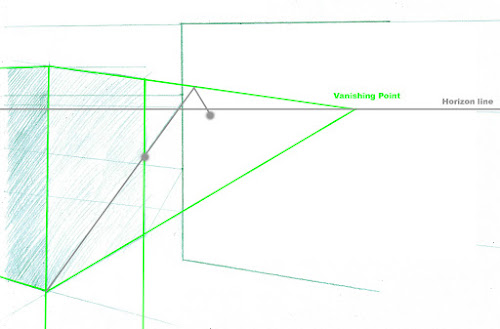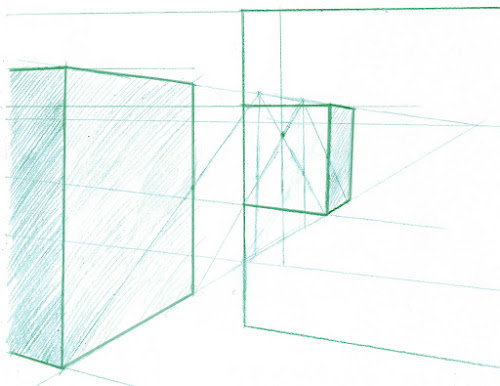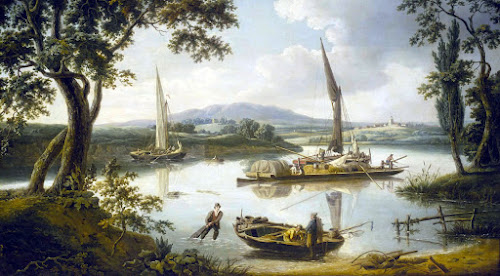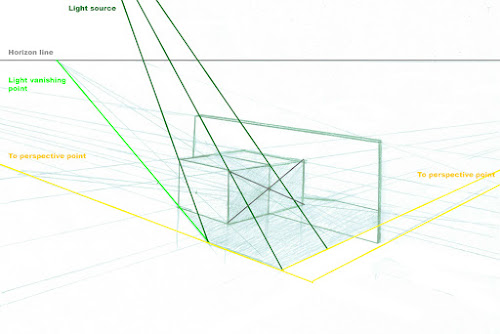How To Draw Mirror Reflections
Reflections In Perspective Drawing- Art Technique
| Geometry and four basic rules determine how to draw reflections in perspective. This is an important skill to learn because everything has reflections in it. With each object in your artwork, you need to consider how objects around it are reflected. Box In Mirror |  |
Reflected Box In Mirror
1. As we consider the painting of the woman in the mirror above, it is helpful to first consider a box instead of the subject of the painting. Let's put a floating box in front of the mirror. I will draw its vanishing lines, with one vanishing point visible in the drawing. |  | |
| 2. First, we need to determine how far the box is from the mirror. We find this by repeating space in perspective. Make a dot in the middle of the far-edge of the box, and draw a diagonal line from the front corner, through the dot, all the way to the other vanishing line. This is a foreshortened distance equal to the width of the box. Reflect this line, in perspective, and make a dot at the point where you determine it hits the mirror. |  | |
| 3. Take these repetition lines (gray) you drew, and reflect them in perspective. This will give you the reflected object's location in the mirror. Additional geometric consideration may be needed. |  | |
| 4. Draw the reflection's perspective lines to the same perspective points as the original objects. This gives you the shape of the reflected object. The far side of our original object is not in view in the mirror, so don't even worry about it. |  | |
| 5. Here are the final proportions for the drawing. Now, using geometry in proportion, you can more easily determine the woman's figure in the mirror. |  |

Reflected Boat On Water
| 1. As we consider the painting of the boat above, use a simplified object on the water in perspective. The image of the boat reflects in equal angles on the water surface. |  | |
| 2. The vertical mast meets the water reflection surface far behind the boat reflection point. Determine the various angle proportions. |  | |
| 3. The mast likewise reflects in equal angles on the water surface. |  | |
| 4. Now, look at the scene in perspective from the eye point. The boat reflects toward perspective points, at the point the boat meets the reflective surface, the water. |  | |
| 5. Use geometric lines diagonally across the center to determine where the boat doubles in perspective, and therefore where the reflection is. Note that the brim of the boat is more curved in the reflection, as you would expect with a tilted edge. To get exact proportions of the curve, you need to draw a box around the entire boat and then reflect it in perspective. |  | |
| 6. Reflect the mast in the same way, except that the mast doubles across the mast reflection line, which is determined from the angle proportions in step 2. |  | |
| 7. Only a small part of the mast turns out to be visible in the reflection, because it is farther away from us than the front of the boat is. |  |
Shadows
| 1. Draw a block directly in front of a mirror, in perspective. |  | |
| 2. Draw diagonal lines across the center of the reflection point to determine where the reflected object edges are. |  | |
| 3. Draw lines of the reflected object to the same perspective points. |  | |
| 4. Follow the tutorial for casting shadows. Use the light point and light vanishing point to draw the object's shadow. (The mirror's shadow is omitted for this demonstration.) |  | |
| 5. To determine the reflected cast shadow, we will reflect the line that casts the shadow (green). Make a dot where this line intersects the mirror's reflection line (grey). Make a dot where the reflected object's edge starts to cast the shadow. Connect these dots and extend a line. |  | |
| 6. The reflected shadow goes to the same perspective points as the object. The only difference is, when the shadow edges change direction, it will use foreshortened mirrored proportions (green lines). |  | |
| 7. The final proportions: |  |
Rules Of reflection
Reflections go to the same vanishing points as the objects they are reflecting. Both the object, its shade, and its shadow are bound by the same three vanishing points. It is easy to figure out the reflection's location if you repeat the original object in perspective until it gets to the reflective surface, and then repeating that same distance into the reflective surface.
Reflection is not a mirror image, but reveals different parts of an object. In top image, we see the back of a woman's head, and in the mirror we see her face. Because of a variance of light sources, her back is pink and her face yellowish and dark. With any reflection, you are going to see different areas of the object and it will have a different brightness. You need to figure out how light hits the object versus how it hits the reflected portion that we see in the mirror. We assume a reflected image will be darker, but that is not always true. The reflection might actually be brighter.
Light reflects in equal angles. The axis for reflection is perpendicular to the surface. It helps to sketch out a diagram of how light hits the object and meets the eye, as I did in the boat example. This gives you angles between the various lines that will help you locate the reflection lines of objects. Sometimes you will have to diagram it out. The geometry gets too complex otherwise. But remember that light will always bounce in equal angles.
Lines & shadows reflect across mirror lines. The most important thing is where the object is reflecting. All objects and pieces are equal distances, in perspective, from their reflected objects and pieces from the reflection line. This helps you figure out shadow lines, because it means you only need to find interfacing points. Complex objects, such as a person's face, can start out simplified with boxlike geometry, and then have organic curves added in.
How Textures Reflect
Water – The texture of the reflective surface determines the brightness and quality of the reflection. Water always has some amount of refraction, which means the image is skewed a bit and we will see some amount through it. The reflection is often strongest when viewed at a slight angle, such as a shore on the horizon. But even then, the reflection will lose the contrast of the image it is reflecting. The ripples of the water also bend the reflection. Even slight waves twist and turn the image, causing incidents of sky and shadow. The axis of reflection angles are all over the place. A careful diagram of the light reflection on the wave determines how to draw this.

Two important effects can be seen in Grimshaw's Reflections on Thames below. The luminescence of the cloudy sky creates a light source that overwhelms the shadow of the bridge. The bridge's reflection is buried behind a strong highlight on the water with high-contrast ripples. This is not exactly what you would see in real life, but this is how the mind registers a water glare, and so speak to the impression of a river scene. Second, the reflections of the street lamps are stretched out vertically. Ripples of water tend to do this, and it is strongest at night.

Reflective Materials – A variety of reflective materials can be seen in Abraham van Beyeren's Silver wine jug, ham and fruit. The metal jug is convex, and therefore sharply skews its reflections to a very tight perspective. The white fruits directly before it are reflected darkly, because we see their shaded parts in the reflection. The scratches and quality of the metal is evident, and a strong highlight and shade punches through the reflections.
The glass object below the jug reflects less strongly. We can see a hazy reflection of the white ceramic bowl to the right of it, the white cloth below it, and darkness from the metal to the left of it. It reflects strong points of highlight but otherwise is hazy. Each material has its own strength of reflection and quality.

Distortion – No natural material gives a perfectly perspectived reflection. The perspective lines in the reflective material will always be curved. Van Eyck investigated the distortion of reflection in his portrait of Arnolfini. The mirror behind the couple bends the reflection lines, due to the convex surface of the metal. Note the brightness of the chandelier, which from the front is much more dim.

How To Draw Mirror Reflections
Source: https://architecturerevived.com/reflections-in-perspective-drawing-art-technique/
Posted by: drinnonhused1980.blogspot.com

0 Response to "How To Draw Mirror Reflections"
Post a Comment